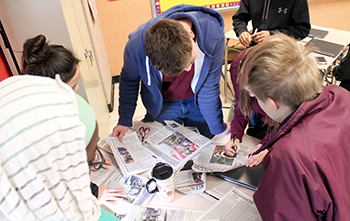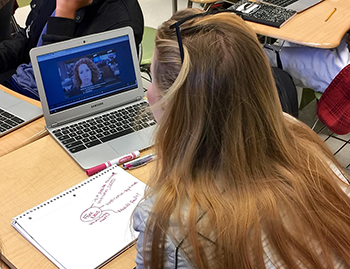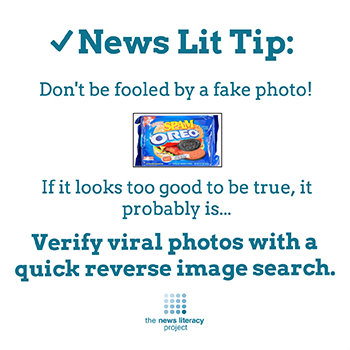In an era of fake news, students must act like journalists
News literacy is rarely required by schools, but it’s more important than ever

Journalism skills can help students identify reliable sources of news.
Gerd Altmann/Pixabay (CC0)
When students sign up for oceanography at San Pasqual High School in Escondido, Calif., many can’t wait to discuss mermaids and monster sharks.
They are quickly chagrined to learn that neither actually exists.

“People come in with hard-core misconceptions that come right off the internet or TV,” says teacher Dan Perreault. (The examples above came from fake documentaries by Discovery Communications. Both shows had three-second disclaimers at the end.) “If I quizzed kids on whether a piece of news was real or not, I bet they wouldn’t pass.”
So when Perreault heard a story on NPR about an online news literacy course, he checked it out. Now, his class is using the News Literacy Project’s checkology lessons to learn how to vet sources and identify reliable news before students delve into a unit on researching evidence of climate change.
Generation Z tends to be adept at most things digital. But several recent surveys and studies show that today’s students have an alarming lack of news literacy. More than 80 percent of middle school students couldn’t tell the difference between real news stories and ads that look like news, a 2016 study by Stanford researchers concluded.
“The Stanford study is right on,” says Peter Adams. He’s senior vice president for educational programs at the News Literacy Project in Chicago, Ill. Today’s middle schoolers and high schoolers “are very savvy with certain things; they are digital natives,” he says. “They intuitively understand that an upside-down caret [symbol] means a drop-down menu, but they don’t really know about sponsored content. They can’t consistently tell an ad from a news report or other piece of content on BuzzFeed, for example.”

Take the kids in the oceanography class: After learning more about news literacy, many realized that not only had they been tricked by fake documentaries, but also that they had often been duped by ads that appeared to be news stories, Perreault says.
As more people — especially young people — get their news from social media, news consumers need to take on some of the roles of journalists, including vetting sources and checking facts.
“The sense of urgency is growing,” says Eric Newton, who teaches at the Walter Cronkite School of Journalism and Mass Communication at Arizona State University, in Phoenix. He also is the innovation chief at Cronkite News, the news division for Arizona Public Broadcasting Service, better known as PBS.
Should news literacy be required in school?
While experts agree that news literacy is as important as other forms of literacy, they don’t always agree about who should be responsible for educating news consumers. There are no national standards for teaching news literacy (although a few states have set their own requirements).
Some experts are adamant that school is the best place to teach these skills. After all, everyone needs them. “Our goal is to see news literacy embedded in American educations,” Adams says. “Students absolutely need these foundational skills. The most fundamental, primary civic actions students take is sharing and creating information.”

Others worry that requiring schools to teach news literacy may not have the desired effect. “There’s part of me that would say yes, I think it should be mandated — but so should financial literacy and home ec,” says Michael Spikes. He directs the Digital Resource Center in Chicago for Stony Brook University’s Center for News Literacy. “Part of me would say no,” too, he says, because he worries that standardizing the curriculum would water it down.
Often, skills for how to consume news and media get ignored in favor of teaching kids how to create media, notes Frank Baker, a media education consultant in South Carolina.
“Teachers can engage kids with iPads in making media. But if they don’t balance that production with analyzing media, then they’re not really doing media literacy,” Baker argues. “They may teach kids how to use their phones as cameras, but how are they teaching strong visual literacy?”
Beyond the media center
News literacy doesn’t have to be limited to the school media center. Some schools fold it into social studies or civics, others into science, some into language arts — and others don’t teach it at all. In many states, it’s up to individual teachers to incorporate news literacy into their curricula — regardless of what subject they’re teaching.
And there can be advantages to teaching news literacy as part of many subjects, experts say.
Weaving news literacy into science classes, for example, can help teach students about evidence, facts and the scientific method. “There’s some overlap between journalism and science,” Newton points out. “There’s no such thing as complete human objectivity, but there are methods of measuring that will not be changed by a person’s point of view — like if a temperature is 98.6.” He adds that “bringing meaning to the facts is the heart of good journalism and good science.”
Another obvious fit for a unit on news literacy is in civics classes. Teachers have long bemoaned the dwindling time spent in social studies and civics, which began after George W. Bush’s No Child Left Behind legislation and continued through the Obama administration’s Common Core standards. By 2004, students in younger grades had about four fewer weeks of social studies per year than in 1988.

That’s changing in some states, however. Illinois recently passed a law requiring civics at some point during high school. And other states have similar legislation, making advocates hopeful that news literacy will find a home in beefed-up social studies classes. “The right to vote doesn’t mean much if you don’t know what’s going on,” Newton contends.
Still, traditional classrooms and teachers aren’t the whole answer, Newton says. “Everyone who cares about civil society,” he says — from parents to journalists to people in the technology business — has a role to play in helping students learn news literacy.
Wherever news literacy is taught, many educators recommend starting by age 12, just before teens can sign up for many social media accounts. Teaching some basic concepts can start even younger. In fact, Newton says, starting at an age when kids are still enjoying their natural curiosity may make sense. “Students can’t start too early.”
Teaching tools
The recent attention on fake news has inspired a slew of educational resources, from fake news finders to full courses on news literacy and in-person workshops. Public editors are eager to take on the topic, and journalists are making themselves available to speak to students. Here are a few resources that help teachers get their journalism game on:
- Checkology: The checkology® virtual classroom from the News Literacy Project is designed for grades 8 to 12 with a dozen online lessons meant to be “blended” into a classroom. The basic version is free; the premium version is also available free for a limited time. Perreault recommends that teachers go through the course by themselves “and shorten the dull moments. … The format is geared toward younger kids, but the content is not. It’s worthwhile even for high schoolers.” His students have said “they feel that it’s not too difficult, “but yet they needed it,” he says.
- Center for News Literacy’s Digital Resource Center: Check out the course pack page for a description of what each lesson plan covers, or email newsliteracy@stonybrook.edu for information on workshops.
- New York Times news literacy lesson plans: A detailed lesson plan for learning about fake news.
- PBS NewsHour Student Reporting Labs: A curriculum with 10 lesson plans.
- American Press Institute: A compilation of news literacy lesson plans.
- The Newseum in Washington, D.C. offers a daily collection of front pages from more than 700 newspapers around the world.
- Fake fake news: A site built in about 20 minutes by George Hopkin, a journalist turned independent digital strategy consultant. Use this formula to show students how easy it is to share fake news: worldtoday.pw/you-can-put-anything-you-want-here-just-make-sure-it-is-just-words-and-hyphens
- Take a look at Charles Seife’s book: Virtual Unreality: The new era of digital deception. He offers copious examples of why, increasingly, reality and the virtual world “can no longer be completely disentangled.” People can hide their identity on the internet, or lie about it. They also can lie about facts or manipulate data so that these seem to support interpretations that are not valid. By this means, he notes, bogus or irresponsible sources may end up exerting undue influence over naïve consumers of news.







